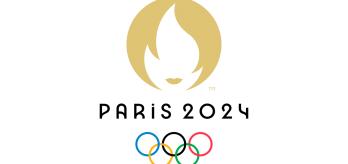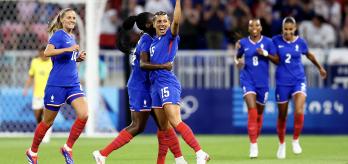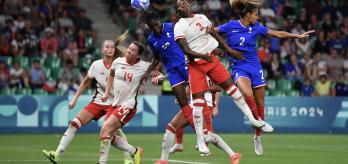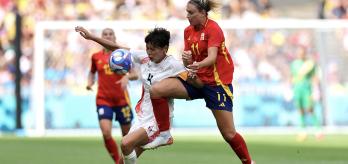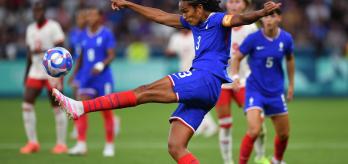This was an extremely tough group with World Cup champions Spain coming in as the favourites despite it being their Olympic debut in the women’s competition. With Japan and Brazil, both top football nations, in alongside Nigeria, who made it out of the group stages at the FIFA Women’s World Cup 2023™, this was always going to be highly competitive. Because of the high quality, it was no surprise that three of four teams advanced from this group, with Spain, Japan and Brazil all advancing to the knockout stages.
Spain
In possession, Montse Tomé’s side liked to dominate the ball. They built attacks from wide areas where they created passing triangles quickly. Their combination play and player movement and rotations in these areas allowed them to get players in behind with overlapping/underlapping runs or through-balls. Once in the final third, they were creative, finding different crossing and passing variations with the intent of creating opportunities to get the ball into the penalty area for attacking players. Attacking midfielders Aitana Bonmatí (6) and Alexia Putellas (11) were always trying to get on the ball in the pockets (wherever the space opened) and face forward, looking to create final-third entries with passes or movement. The inverted role of right-back Ona Batlle (2) was also interesting as she often created overloads when she advanced up the pitch.
Out of possession, Spain pressed high and quickly in a very collective and cohesive way, as centre-forward Salma Paralleulo (9) triggered the aggressive press and the team followed. Their centre-backs played tight to opposition centre-forwards, preventing them from turning. As a team, La Roja worked hard to force mistakes and regain possession high or force the opposition to play long.
Japan
Futoshi Ikeda’s team showed great understanding and the ability to move between multiple formations. They set up as a 1-5-3-2 and shifted into a 1-3-4-3 when in possession, where they proved very dangerous when they played forward quickly and in behind the opposition defensive line. Their forward players timed runs exceptionally well, constantly making movements and offers to receive the ball. They executed lots of player rotations and movement in midfield to get players on the ball (and facing forward) in the pockets. They also sought to keep their wide-forwards narrow so that their wing-backs could push on into the channels and exploit the spaces in wide areas.
Japan’s set plays were always creative and well-rehearsed, keeping opposing teams guessing. They demonstrated the ability to score amazing free kicks. Goalkeeper Ayaka Yamashita (1) has proven to be a key player in this team, demonstrating good positioning and confidence when defending her goal, while also being heavily involved in their build-up, with great variation between her short and long distribution.
Japan have played a few different defensive formations in this tournament and they have been able to move fluidly between them, seamlessly adjusting between a 1-5-3-2 and 1-5-4-1 set up. During the group stage they defended in both a high press and low and mid-blocks depending on the situation, and they were very cohesive and connected. This made it difficult for opponents to play through them, which in turn forced mistakes and long balls. They showed teams outside and were good at getting numbers back in recovery to defend.
Brazil
When they had possession, Arthur Elias’s team played in multiple formations, with 1-4-4-2, 1-3-4-3 and 1-3-2-5 all being used. As they built and progressed their play, their centre-backs used switches of play to exploit space on the opposite side and change the point of attack.
Brazil liked to get players forward quickly and their full-backs pushed high to support the wingers, breaking lines with receptions in behind and forward passes. In addition, they made overlapping and underlapping runs in the attacking transition to create overloads in wide areas. Attacking midfielder Marta (10) is still a key player for them, but she received a red card in their final group game against Spain and is suspended for the quarter-final.
When they lost the ball, their tactics varied between pressing high and counter-pressing to regain possession in the final third. When a lower block was required, they used a 1-5-4-1 set-up and defended very cohesively as a team, proving difficult to play through.
Nigeria
Under the guidance of head coach Randy Waldrum, Nigeria liked to attack in a 4-2-3-1 formation and were most dangerous when their holding midfielders got on the ball facing forward. From this position, they looked for quick, straight balls between the lines and into the pockets, with receiving players progressing the ball into wide areas. Nigeria also tended to deliver crosses early, targeting the dangerous territory between the opposition goalkeeper and their defensive line.
When forced to defend, they favoured a low or mid-block in a 1-4-5-1 structure. They were very cohesive and disciplined, aiming to deny the opposition space in behind. They defended in numbers and were very competent in 1v1 defensive situations. They worked very hard at tracking runners and blocking passes and attempts at goal in their defensive third. Goalkeeper Chiamaka Nnadozie (16) marked herself out as a key player in this team, making a variety of crucial saves. She is also calm on the ball under pressure.
Quarter-Finals
With the standard of this competition being so high, all four quarter-finals are utterly fascinating and difficult to predict. It’s fair to say that all of the eight remaining teams will have aspirations of winning a medal, so the next four games, all to be played on Saturday, 2 August, promise to be enthralling.
The schedule is as follows (kick-offs are given in Central European Time):
-
15:00 USA v Japan (Parc des Princes, Paris)
-
17:00 Spain v Colombia (Stade de Lyon)
-
19:00 Canada v Germany (Stade de Marseilles)
-
21:00 France v Brazil (Stade de la Beaujoire, Nantes)




